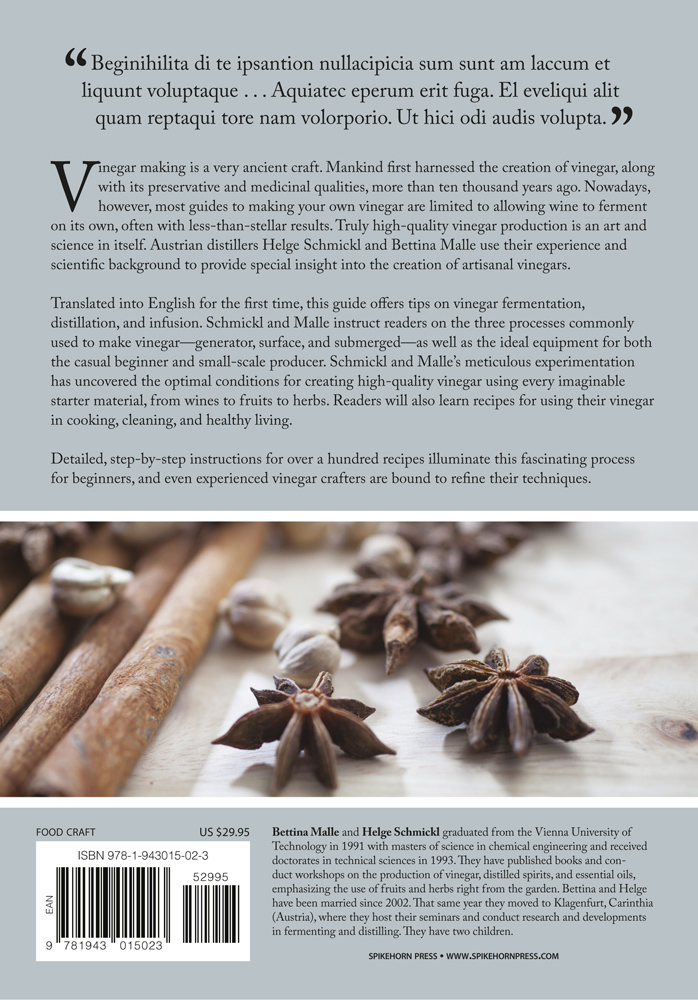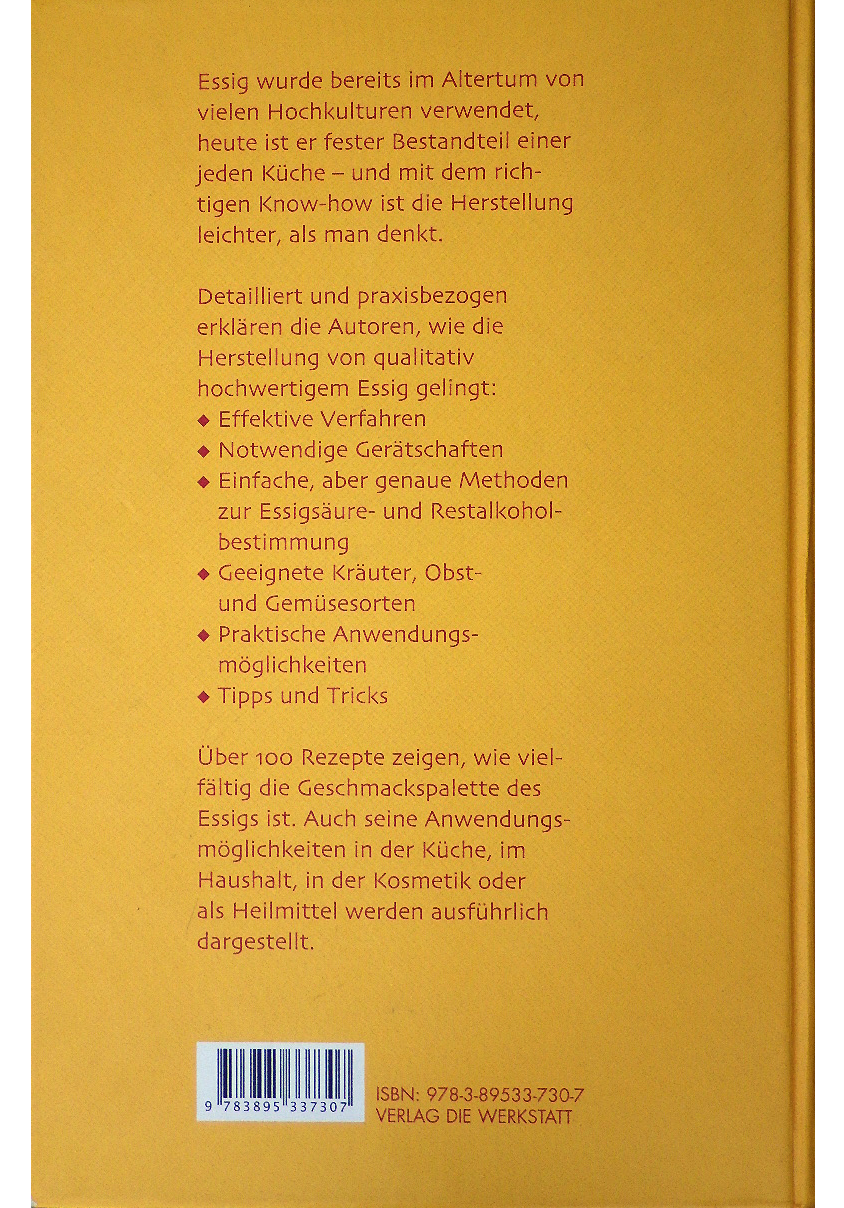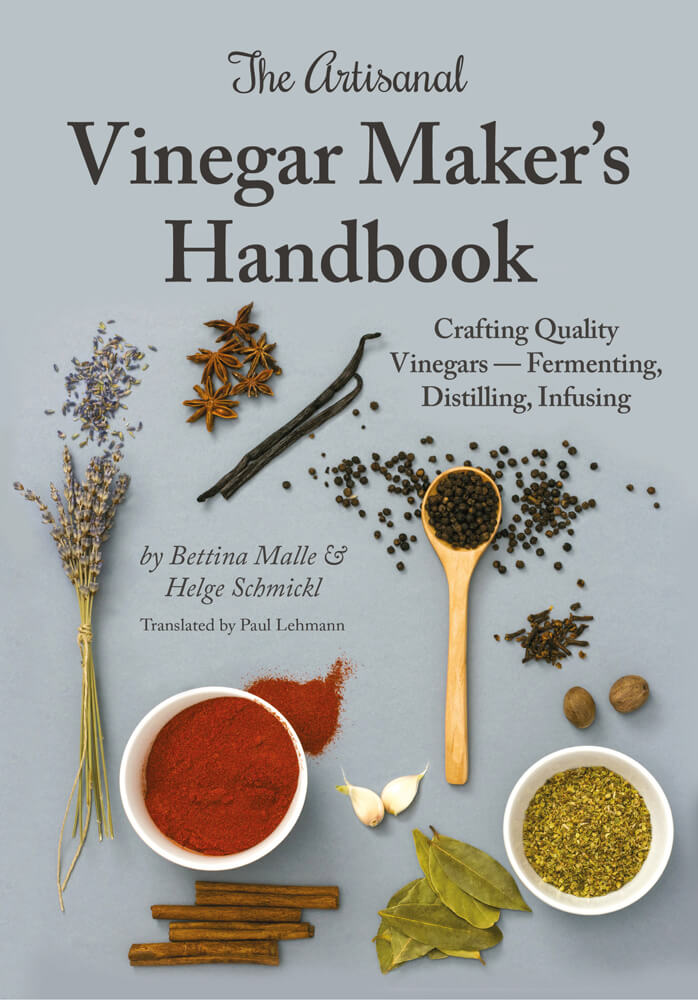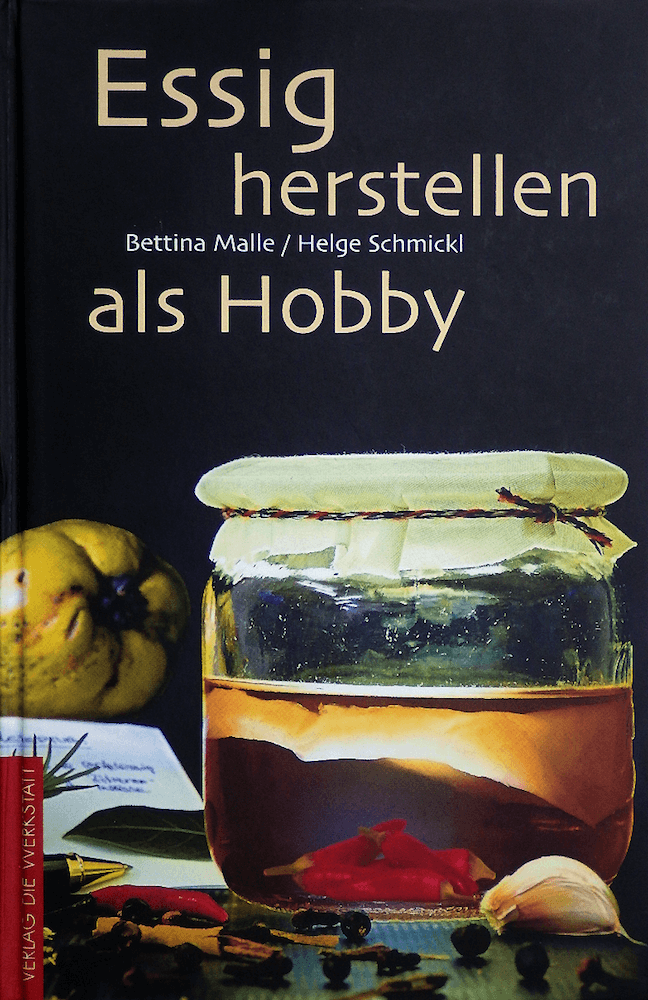Vinegar Production Books
 English Version
English Version 
Bettina Malle, Helge Schmickl
Publisher: Spikehorn Press U.S.A.,
© 2015
178 pages, hardcover, full-color
photographs & illustrations
ISBN: 978-1-943015-02-3
 German Version
German Version

Bettina Malle, Helge Schmickl
Verlag Die Werkstatt
3. Auflage 2020
208 Seiten, Hardcover,
durchgehend farbig bebildert
ISBN: 978-3-7307-0229-1
Vinegar with the generator process – a step-by-step guide
Bettina Malle – Helge Schmickl
E-Book
31 pages, 2021, 1st edition
Price: 9,00€
Fermented vinegar + balsamic vinegar + infused vinegar – more than 300 recipes
Bettina Malle – Helge Schmickl
E-Book
79 pages, 2021, 1st edition
Price: 15,00€
Make Vinegar at Home – Step-by-Step Instructions
Bettina Malle – Helge Schmickl
E-Book
31 pages, 2020, 1st edition
Price: 9,00€

The Artisanal Vinegar Marker’s Handbook
If you would like to make vinegar yourself in the best quality, you can learn the art of vinegar making with the help of our book The Artisanal Vinegar Maker’s Handbook:
- Making a mash – the foundation of homemade vinegar
- Vinegar fermentation (see also How to make vinegar – the online course and Learn making vinegar)
- Vinegar making equipment and measuring devices for making vinegar
- Additional flavors and aromas using the generator process
- Analyses for making vinegar at home
- Numerous vinegar making recipes for fermented vinegars and infused vinegars
Making a mash
How to make vinegar and obtain good quality? First you must make the perfect mash. The quality of the mash is the foundation for making vinegar. Using rotten and dirty fruit can never lead to high-quality vinegar. You will find precise guides and recipes to make mashes easily yourself, and you will find out everything about possible problems (infections, overoxidation, yeast film, etc.) during fermentation and the measures to counteract these.
Vinegar fermentation
You will find a detailed description for starting vinegar fermentation. How can you make a mother of vinegar yourself, or store an active mother? How do I start vinegar fermentation? What problems can arise, and how can I remedy them? Vinegar calculations of the required quantities of acid, alcohol, water and fermentation starter.
The vinegar equipment for making vinegar
Classic surface process and vinegar fermentation using the generator process. How does the optimum vinegar generator have to be setup correctly from a process technology perspective? What materials can I use? How do I construct or alternatively recognize functional equipment? Regardless of whether you would like to build the equipment yourself or buy it, here you can acquire the necessary know-how to end up with the perfect vinegar making equipment for your homemade vinegar.
Additional flavors and aromas from the packing material technique
Detailed description of the fermentation process to refine the vinegar during the fermentation process using additional fruit, herbs, etc. (raspberries, coffee, nuts, raisins, orange peel,…) or unfermented products such as asparagus, tomatoes etc..
Analysis for acetic acid and alcohol content
Learn the necessary analysis methods and vinegar calculations so you can analyze the alcohol and acetic acid content yourself at any time.
Recipes
What is vinegar made of? Numerous recipes for homemade vinegar with precise information for fermented vinegars and infused vinegars. Discover how you can make the greatest variety of vinegars at home yourself.
Table of contents:
Foreword
- Historical review
- Fundamentals
What is vinegar?
Chemical processes: How does vinegar form, vinegar bacteria, thermal balance
Types of vinegar: Fermented vinegar, infused vinegar, minimum acidity - Microbiological processes for making vinegar
Surface processes: Orleans process, Pasteur process
Captive processes: Rolling generators, rotating generators, Boerhaave process, Schüzenbach’s quick vinegar process, generator processes (circulating or trickling generator), submerged processes - Making vinegar yourself
- ALCOHOLIC FERMENTATION
Preparation of the mash, types of fruit and starchy products, treatment of the fruit, fermenting container, conventional mashes, high-grade mashes, starch mashes, checking the progress of the fermentation, end of fermentation, fermentation problems, filtration, storage, using finished wine/must/distillate - VINEGAR FERMENTATION
Surface process: Simple vinegar fermentation (equipment and materials, performing simple fermentation), improved surface method (equipment and preparation, fermentation container and filling level, airflow, water bath, active vinegar culture, mother of vinegar, pasteurization, instructions for the surface process)
Generator process: Advantages of the generator process, basic assembly of the equipment (reactor, packing material, fermentation medium container), Schmickl vinegar generator, do it-yourself equipment, instructions for the generator process, pre-treatment of the filling material, acidification (acidification with living vinegar, acidification with fermentation starter, acidification with zeolites), starting the process,
normal operation
Reactivating, multiplying and storing vinegar cultures: living vinegar, mother of vinegar, active filling material, freezing vinegar cultures
Fermentation problems, fungal contamination, unwanted smells, parasites: Fermentation problems, fungal contamination (yeast film, unwanted smells, pests (vinegar eels, vinegar flies, vinegar mites, etc.), alcohol issues, causes and remedies, overoxidation, slime accumulation
- ALCOHOLIC FERMENTATION
- Chemical analysis:
- DETERMINING THE ACETIC ACID CONTENT
Titration with burette (necessary equipment, titration instructions, taking readings from the burette), acidometer cylinder and blue caustic solution (equipment and instructions), hydrometer (vinegar spindle) - DETERMINING THE ALCOHOL CONTENT
Alcohol content of a distillate: Hydrometer (alcoholmeter), refractometer, pycnometer
Alcohol content in the mash and in the vinegar: Vinometer, ebullioscope, alcohol measurement using the Rebelein method, photometric alcohol measurement, alcohol measurement using the Schmickl method (acidity determination, semi-micro distillation, alcohol determination), alcohol determination with a vinegar spindle) only for vinegar) - COMPARISON OF DIFFERENT MEASUREMENT METHODS
- RELATIVE DENSITY MEASUREMENT METHODS
Vinegar spindle, alcoholmeter, Oechsle scale, Klosterneuburger must scale
- DETERMINING THE ACETIC ACID CONTENT
- Further treatment
Filtration, storage, refinement, carbon treatment, bottling, pasteurizing, dyeing and preserving - Recipes
- FERMENTED VINEGAR
- Pineapple vinegar, apple vinegar, apricot vinegar, banana vinegar, beer vinegar, pear vinegar, blackberry vinegar, strawberry vinegar, fig vinegar, vegetable vinegar, grain vinegar, pomegranate vinegar, rose hip vinegar, raspberry vinegar, elderberry vinegar, currant vinegar (redcurrant vinegar), potato vinegar, cherry vinegar, cherry plum vinegar, greengage vinegar (greengage-plum vinegar), malt vinegar, mango vinegar, molasses vinegar, mead vinegar, mirabelle vinegar, medlar vinegar, whey vinegar, must vinegar, nut vinegar, peach vinegar, quince vinegar, rice vinegar, raisin vinegar, sloe vinegar, pomace vinegar, rowanberry vinegar, juniper vinegar, wine vinegar, sugar beet/sugar cane vinegar, prune plum vinegar, plum vinegar
- FERMENTED VINEGAR WITH AROMATIC FILLING MATERIAL
General instructions, fruit (fresh, berries, fruit with pits and cores), wood (beech, oak, etc.), coffee, herbs, hay flowers, coniferous wood (fir, spruce, Swiss pine, etc.), dried fruit, nuts, pumpkin seeds, juniper berries, cinnamon, citrus fruit (grapefruit, oranges, lemons, limes) - BALSAMIC VINEGAR
Balsamic vinegar made of thickened fruit juice, balsamic vinegar made of high-grade mash - INFUSED VINEGARS
Herb vinegar: Basil, wild garlic, savory, borage, dill, tarragon, fennel, nasturtium, chervil, coriander, lavender, lovage, marjoram, mint, oregano, parsley, salad burnet, rosemary, sage, chives, thyme, juniper, hyssop, lemongrass, lemon balm
Spice and aromatic vinegar: Essential oils, chili (tabasco sauce), spruce tips, elderflowers, honey, ginger, garlic, caraway, horseradish, oranges, cloves, peppers, hot peppers, pepper, roses, mustard seeds, dried fruit (apricots, figs, plums, raisins, etc.), violets, cinnamon, Swiss pine, lemons, onions
Aromatic fruit vinegar: Apples, apricots, pears, blackberries, cranberries, strawberries, figs, rose hip, blueberries, raspberries, currants, cherries, quinces, prune plums, plums, greengages, sloe mixtures
- Uses
- COOKING
Aperitifs, digestifs, salads, appetizers (poached eggs, sautéed asparagus), soup (cold vegetable soup, pumpkin soup), main dishes (goulash, sweet and sour chicken), spreads (apple spread, tuna spread), desserts (strudel dough, vanilla ice cream salad), mustard, marinades, pickles. - HOUSEHOLD ITEMS
Household disinfection, odor removal, weed killer, stain remover, de-scaler, mold removal, cleaning agents (sanitary area, washing machine, windows, mirrors, oven, dishwasher) - HEALTH
Wart removal, corns, weight loss, vinegar poultices for fevers, hemorrhoids, varicose veins, classic morning tonic, constipation, bruises and insect bites, hangovers, hiccups, colds (common cold, sore throat, cough, fever chills) - COSMETICS
Hair tonic (hair loss, dandruff, lice), steam inhalation, facial toner, exfoliating scrub, skin blemishes, foot bath, bath additive
- COOKING
- Legal situation
Germany, Austria Switzerland
Epilogue
Index

Vinegar – Generator Process
The compact guide to vinegar production: learn how to make vinegar using the generator process in short step-by-step instructions. There are no background explanations, without digression, the book briefly and succinctly goes through the individual steps of production.
Price: 9,00€
Table of contents:
- What is the generator process?
- How does the generator process differ from the surface process, what are its advantages?
- How to build an apparatus for the generator process?
- What starting materials are needed for the generator process?
- How do I make a vinegar fermentation with simple measuring equipment and how with accurate analysis?
- What are the options for starting a vinegar fermentation?
- How to grow a mother of vinegar?
- How to store the finished vinegar and how to further treat it.

Vinegar Recipes
This extensive collection of vinegar recipes has been compiled by us over many years. It includes classics such as apple cider vinegar, wine vinegar, and balsamic vinegar, as well as more unusual recipes such as coffee, raisins, nuts, orange and honey.
Price: 15,00€
Table of contents:
- The book contains basic recipes for fermented vinegar, fermented vinegar with aromatic packing material, balsamic vinegar and infused vinegars.
- The vinegar recipes are sorted alphabetically from A-Z, you will find more than 300 different recipes in this collection.
- For each recipe, special features and possible deviations from the basic recipe are indicated.
- The information for each recipe is divided into fermented vinegar / vinegar with aromatic packing material / balsamic vinegar / infused vinegar. In this way you can immediately recognize for which type the respective fruit / plant material is particularly suitable or, in the case of many types of fruit and plants, all types of production are also useful.
- Many vinegar fermentations we have carried out so far, are given in table form with detailed quantities.

How to Make Vinegar at Home
Compact guide to make your own vinegar: Learn in short step-by-step instructions how to make vinegar with the surface process. There are no background explanations, the book goes into the individual production steps briefly and concisely.
Price: 9,00€
Table of contents:
- What is vinegar and how is it made?
- What types of vinegar and production methods are available?
- Which vinegar bacteria can I use to begin fermentation?
- Which raw materials can I use for vinegar fermentation?
- How do I make a simple vinegar fermentation? Examples with exact quantities and a list of the required equipment.
- How can I increase the amount of vinegar?
- How to grow a mother of vinegar?
- How can I improve vinegar fermentation with simple methods? Examples, material list for the simple devices.
Copy link
Zum kopieren alles markieren und CMD+C (Strg+C) drücken.
